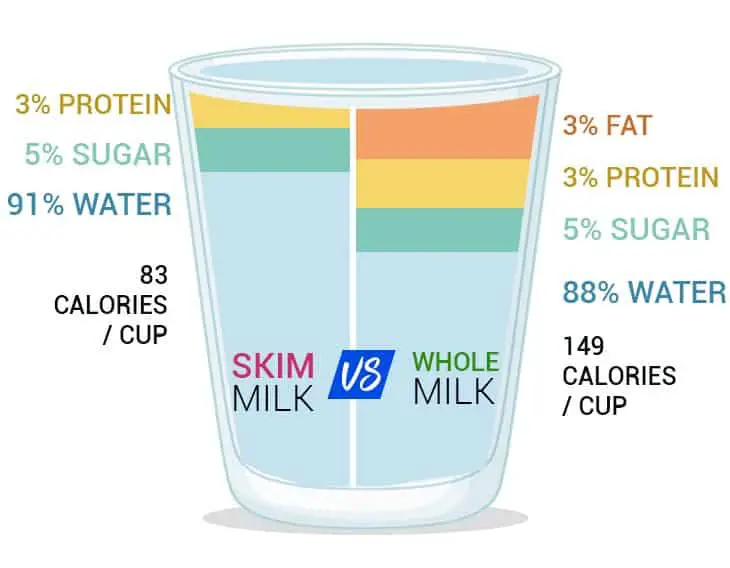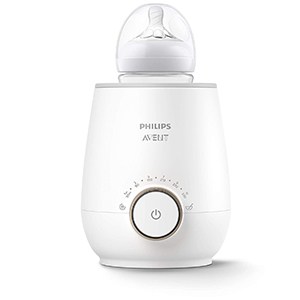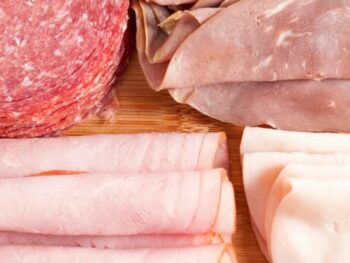It may have occurred to you that you need whole milk but you can’t find it. But instead, all the milk in the store is homogenized milk. Now you don’t know what to do.
So, is homogenized milk whole milk?
The answer is yes and no. If whole milk is homogenized, it has the same nutrition facts as whole milk. This means you can use this homogenized milk instead of whole milk. But if it’s homogenized skim milk, you can’t use this milk.
Not sure about the details yet? Get on board with us and solve this mystery!
Are Homogenized Milk and Whole Milk The Same?
Is homogenized milk and whole milk the same thing? The answer to that question can be as confusing as cooking oil evaporating! Because some homogenized milk is whole and some are not!
Owing to the fact that homogenized milk can be whole milk. But not all homogenized milk is whole milk and vice versa
Wondering how this works? Let’s figure it out!
To clear this confusion, you should understand the features of different types of milk first. We usually notice 4 types of milk in our daily life so let’s start off with them!
Whole milk is the most unadulterated form of milk. Simply put, it is the purest form of milk with the highest nutrition value. The feature that differentiates types of milk is the percentage of fat in the milk. In whole milk, there is about 3.25-3.5% fat. Whole milk is creamy and rich in flavor.
Skim milk or skimmed milk contains around 0.1-0.3% fat. As we said, the type of milk depends on the amount of fat in it. All the other nutrients like calcium, vitamins, potassium, etc. remain the same as whole milk.
Skim milk is less creamy and insipid. Because the fat or cream that makes milk rich is compromised when skimming. Later, the cream is used in making regular or high temp cheese along with other dairy products.

The only difference between whole milk and skim milk is, whole milk contains more than 3% fat. On the other hand, skim milk contains less than 0.5% fat.
But the next two types of milk we’re going to discuss don’t have any nutrition facts related to them. They are just two processes.

The first one is pasteurized milk. When milk is heated at around 700°C temperature, it’s pasteurized milk. This kills harmful bacteria and makes the milk safe to consume. It doesn’t matter if it’s whole milk or skim milk. If milk is heated at this temperature, it is pasteurized milk.
The second process is homogenization. Milk has a rich cream or malai stored on the top when left for a long time. That is the fat portion of milk. Due to the big size of its molecules, the cream attracts each other and gets thick when clustered together.
Homogenization disperses that cream into very tiny pieces. This is done by taking the milk through extensive pressure. As a result, the cream or fat dissolves in the milk uniformly.
Previously we said, homogenized milk sometimes can be whole milk and sometimes not. Did you get it yet?
If we homogenize whole milk, it is homogenized whole milk. And if we homogenize skim milk, it is homogenized skim milk.
Homogenized Whole Milk vs Whole Milk – Explained
You might be wondering, “if homogenization doesn’t change any nutrition, why is it even homogenized?”
To know that, let’s take a quick look at the differences between whole milk vs homogenized whole milk-
| Feature | Raw Whole Milk | Homogenized Whole Milk |
| Shelf life | 4-7 days | 10-12 weeks |
| Cooking friendliness | Less | More |
| Fat size | Bigger | Smaller |
| Cream on top | Yes | No |
With increased shelf life, you can store milk more than regular milk. On top of everything, raw whole milk lasts only 4-7 days at most! So, does this mean the milk we buy from stores is homogenized?
Yes, almost all of the packed milk we buy from stores are both pasteurized and homogenized! Also, as the ingredients of the milk are broken into smaller pieces, it is easier to digest homogenized milk.
Now comes another big question, “should you feed babies homogenized milk?”
As we’ve seen earlier, homogenized whole milk is whole milk with smaller pieces of fat. If whole milk is safe for your child, homogenized whole milk is the same thing.
If you want to feed your child milk, make sure it’s warm. Concerned about what to use for that? Here are some of our suggestions for bottle warmers:
Philips Avent Fast Baby Bottle Warmer

Tommee Tippee Bottle Warmer

Now your baby can have warm milk whenever it’s feeding time! It doesn’t matter if it’s whole milk or homogenized whole milk.
Sometimes someone may have some heart disease or other problems that get triggered by fat. In that case, you should go for skim milk whether it’s homogenized or not.
Not to mention, as there are no creams on the top, homogenized milk is also better for cooking. Because homogenized milk is uniform and gets mixed with other ingredients better.
But if we look at the disadvantages, there are not many. Because homogenization doesn’t change any nutrition value of the milk. It’s just the fat and some other ingredients are broken into smaller pieces.
Milk is taken through the homogenization process not because of nutrition facts. It’s done mainly for the commercialization of milk so it can last longer.
When commercial companies collect milk, they aren’t collected from one single cow. Instead, there are lots of cows that give milk. But hold on! If there are lots of cows, is the milk the same?
Definitely not! Different cows give milk of different consistencies, different percentages of fat. But if we mix all of them together, would it be good to go to the market?
No, it won’t. If we mix milk of different consistencies together, the mixed milk will not have a uniform consistency. The thicker milk will stay in the bottom where the lighter milk will go up. Also, the color will not be natural at all!
This is why milk is homogenized. In the homogenization process, the milk is taken through very tiny holes with high pressure. It breaks the fat globules into very tiny pieces that prevent them from clustering and creating a layer of cream. As a result, the milk from different cows acquires the same consistency and color.

But once whole milk is homogenized, we can never skim it. Because in order to skim the milk, we have to get rid of the fat. But now it will not even form any cream since it has been homogenized!
Alternatives of Whole Milk
Now you might be wondering, “where to use which milk then? Can I use homogenized milk instead of whole milk? Is it safe?”
If you are looking for raw whole milk but can’t find any, you can use homogenized milk. But you can’t use homogenized skim milk though!
Sometimes, the situation can get reversed though! Imagine you need whole milk, but the homogenized milk you have is skim. What would you do then?

Don’t sweat yet! Here are some products that can be used as a substitution of 1 cup of whole milk-
Heavy Cream
Heavy cream contains around 30% milkfat. If you have heavy cream at home, you can easily turn it into whole milk in 2 different ways.
- Heavy Cream + Skim Milk: Add ⅛ cup of heavy milk with ⅞ cup of skim milk and stir them decently. Now you can use them as a substitute for whole milk.
- Heavy Cream + Water: To replace 1 cup whole milk, add ½ cup water and ½ cup heavy cream and mix them.
This alternative tastes the closest to whole milk. So, you can substitute it any time!
Half and Half
Another way you can substitute whole milk is with Half and Half. It contains about 10% milkfat. You can add skim milk or water with Half and Half to substitute for whole milk.
- Half and Half + Skim Milk: Take ⅝ cup of skim milk and add ⅜ cup of Half and Half with it. This increases the fat portion of the milk.
- Half and Half + Water: If you don’t have skim milk at home, no need to worry. Just take ¼ cup plain water and mix it with ¾ cup Half and Half.
Although, half and half tastes close to heavy cream. It’s a watered-down version of whole milk, so there’s some flavor loss.
Yogurt
Yogurt is way thicker than milk. So, keep adding water with it until it obtains the same consistency as milk. When it does, you can use this as a 1:1 substitute for whole milk.
But you’ll get a slightly sour kick if you use yogurt as an alternative.
So, if you’re cooking and lacking whole milk, feel free to use any of the aforementioned combos!
This is pretty much everything regarding homogenized milk and whole milk. We hope you’ve found your answer.
FAQs
Question: Does homogenized milk taste different?
Answer: No, homogenized milk doesn’t taste any different than regular milk. Because the ingredients of the milk don’t change when homogenized.
Question: Is buffalo milk whole milk?
Answer: Buffalo milk contains around 7-8% fat. This means it is whole milk but not the same as cow milk.
Question: Is Kirkland homogenized milk whole milk?
Answer: Kirkland has several types of milk. So, if the pack says it has around 3% fat, it is whole milk.
Conclusion
So, “is homogenized milk whole milk?”
We hope we’ve been able to clear your confusion regarding whole milk and homogenized milk. Now you know which milk you have to get.
If you have any other queries or suggestions, feel free to leave a comment.
Till then, happy drinking!
- How Long Does Vegan Butter Last? Mystery Solved - January 9, 2024
- How Long Does Vegan Mayo Last - January 2, 2024
- From Pot to Plate: How Long Does Vegan Chili Last in The Fridge? - December 26, 2023





 The Secret to No-Fail Pita Bread!
The Secret to No-Fail Pita Bread!